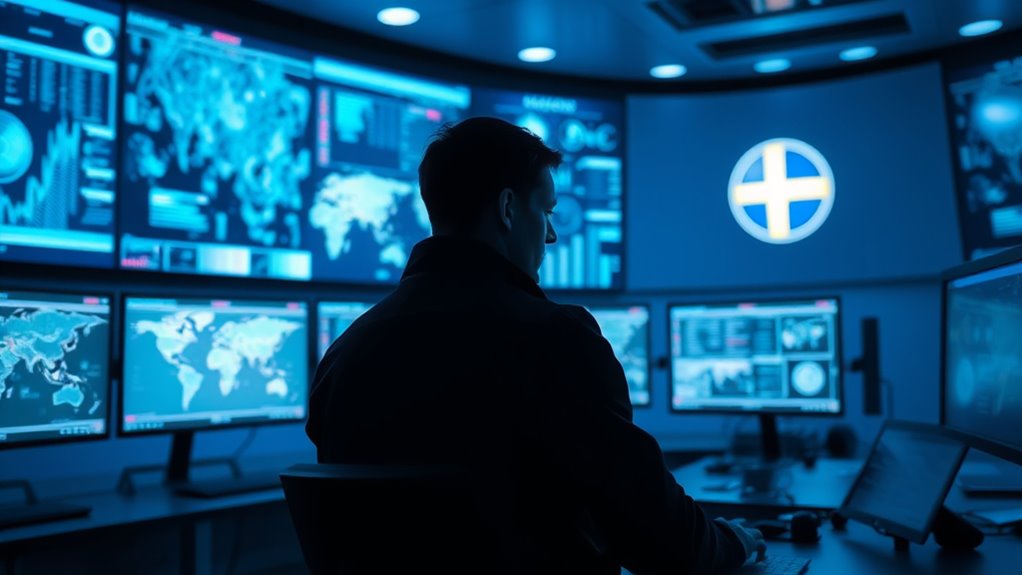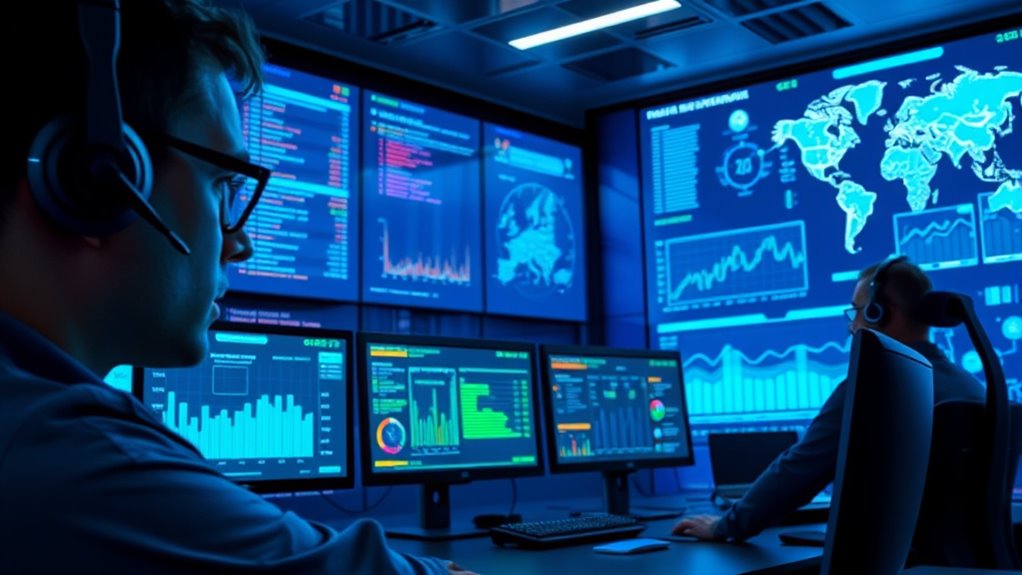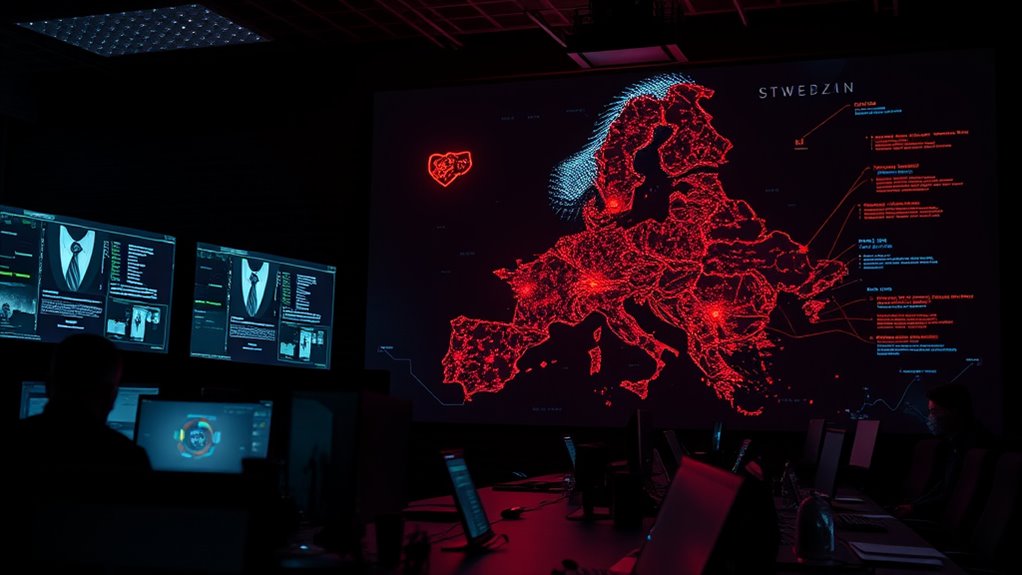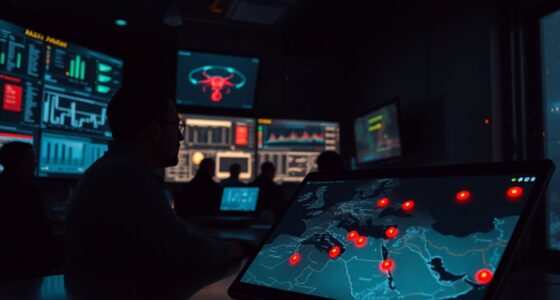Sweden's Säpo is harnessing AI to strengthen its defenses against rising Russian cyber threats. By analyzing vast data sets, AI enhances threat detection and automates responses, making your cybersecurity more effective. Proactive measures like multi-factor authentication and real-time network monitoring help catch suspicious activity early. Collaborating with international partners also boosts their defensive capabilities. The landscape of cybersecurity is continually evolving, and there's more to uncover about how these strategies are being implemented.
Key Takeaways
- Säpo employs AI to enhance threat detection by analyzing large data sets for potential cyber threats from state-sponsored actors like Russia.
- Machine learning algorithms enable AI systems to adapt to evolving cyber threats, improving response times and overall defense capabilities.
- Proactive measures, such as regular software patching and multi-factor authentication, are vital in countering Russian cyber tactics.
- Collaboration with NATO, the EU, and U.S. Cyber Command strengthens Sweden's cybersecurity defenses against sophisticated Russian cyber operations.
- Continuous adaptation of AI technologies and investment in advanced cybersecurity tools are essential to address emerging threats in cyber warfare.
Overview of Sweden's Säpo and Cybersecurity Landscape

As Sweden faces increasing cyber threats, particularly from Russia, the role of Säpo (the Swedish Security Service) becomes crucial in safeguarding the nation's security.
You're likely aware that Säpo's mission encompasses counter-espionage, counter-terrorism, and protecting dignitaries. With around 1,400 employees, many of whom are trained police officers, Säpo operates under the Ministry of Justice, focusing on domestic safety. Säpo's functions include conducting investigations into serious crimes against national security, which is vital in today's cyber landscape.
Säpo's mission includes counter-espionage, counter-terrorism, and protecting dignitaries, ensuring Sweden's domestic safety with a skilled workforce.
The cybersecurity landscape in Sweden is challenging, as most cyber-attacks stem from foreign powers, notably Russia. These attacks can undermine democratic processes and foster distrust among citizens.
Säpo actively collaborates with other agencies to combat these risks while raising awareness about protective measures. It's vital for you to understand how these efforts shape Sweden's approach to national security.
The Role of AI in Enhancing Cyber Defenses

While cyber threats continue to evolve, AI plays a vital role in strengthening defenses against these dangers. With its enhanced speed and accuracy, AI quickly analyzes vast data sets to detect anomalies and potential threats, significantly reducing response times. It excels at recognizing complex patterns that can be challenging for humans, improving threat detection capabilities. AI continuously scans networks for vulnerabilities, automatically flagging weak points and providing predictive insights to anticipate attacks. Additionally, AI prioritizes risks based on their potential impact, streamlining patch management and ensuring critical issues are addressed first. By automating threat response and incident analysis, AI enhances overall cybersecurity, allowing teams to focus on strategic tasks while effectively mitigating emerging threats. This capability is particularly important as AI enables systems to learn from data and adapt to evolving threats, making it an essential tool in modern cybersecurity.
Identifying and Mitigating Russian Cyber Threats

Identifying and mitigating Russian cyber threats requires a proactive approach, especially given the sophisticated tactics used by state-sponsored actors. You should recognize groups like APT28 and APT29, which exploit known vulnerabilities and use tools like Nmap and Shodan for reconnaissance. Regularly patching these vulnerabilities is crucial to prevent unauthorized access. Implementing multi-factor authentication can significantly enhance your defenses. Pay attention to unusual network behavior and monitor authentication logs to catch any suspicious activity. Additionally, maintaining network visibility with tools like RevealX allows you to detect unauthorized scanning. By enhancing your overall cybersecurity posture and practicing incident response, you can effectively counteract these persistent threats targeting critical infrastructure. Understanding the CHAOS model of Russian cyber tactics is essential for recognizing the various methods that adversaries may employ to destabilize systems and manipulate information.
Collaboration With International Partners

Cybersecurity efforts against Russian threats can't be effective in isolation; collaborating with international partners is vital. Sweden's partnerships with NATO and the EU enhance alert levels and push for stronger cyber sanctions against Russia.
By sharing intelligence with U.S. Cyber Command and tech companies, you're bolstering defenses against evolving threats. Additionally, non-profits play a crucial role in facilitating insights between Ukraine and U.S. cybersecurity efforts. Ukrainian cyber defenders mitigated over a thousand cyber incidents last year, demonstrating the impact of collaboration.
As economic pressures shape policies, maintaining open lines of communication is essential for coordinated responses. You must also focus on cross-sector collaboration to protect sensitive activities in Sweden.
Ultimately, unified action not only strengthens your defenses but also disrupts Russian cyber infrastructure, ensuring a safer digital landscape for all.
Real-Time Threat Detection and Response

As the threat landscape evolves, implementing real-time threat detection and response strategies becomes essential for safeguarding your digital assets. By utilizing behavioral analysis, you can establish baselines of normal activity, helping to spot anomalies that indicate potential threats. AI and machine learning enhance this process, allowing for faster identification through predictive analytics. Real-time monitoring tools, including SIEM and IDS, continuously track network activity, while cloud-native monitoring secures your virtual environments. With GPU-based processing, threat scanning speeds up significantly. Furthermore, real-time threat detection minimizes damage by identifying and responding to cyber threats as they occur, ensuring your organization remains resilient against advanced threats. Integrating autonomous responses can isolate affected devices and block suspicious connections automatically. This proactive defense empowers your security team to tackle threats before they escalate, ensuring a robust security posture in an ever-changing cyber landscape.
Continuous Learning and Adaptive Security Measures

While the digital landscape constantly changes, embracing continuous learning and adaptive security measures is crucial for staying ahead of potential threats.
By continuously updating your knowledge about new attack vectors and vulnerabilities, you enhance your ability to detect and respond to security incidents. This ongoing education helps you understand the security implications of emerging technologies like AI and IoT, ensuring compliance with regulations such as GDPR and CCPA.
Adaptive security architecture provides a dynamic defense, utilizing real-time analytics and AI-driven threat prediction to identify and mitigate threats.
Future Challenges in AI-Enhanced Cyber Warfare

The rise of AI in cyber warfare presents unprecedented challenges that demand urgent attention. You face a landscape where sophisticated attack automation allows adversaries to launch complex, coordinated strikes. As AI adapts in real-time, your defenses struggle to keep pace with evolving tactics. The increased attack surface, driven by AI-assisted coding, exposes vulnerabilities you must address. AI-driven social engineering, including convincing phishing attempts, complicates your security efforts. Furthermore, the emergence of AI-generated misinformation threatens to manipulate public perception and disrupt economies. As quantum computing looms, current encryption measures may become obsolete. Without robust AI ethics and defensive strategies, you risk falling behind in this rapidly evolving arena, making it imperative to rethink cybersecurity approaches. 40% of all cyberattacks are now AI-driven, highlighting the urgency of enhancing your defenses against these increasingly sophisticated threats.
Frequently Asked Questions
What Specific AI Technologies Does Säpo Utilize for Cybersecurity?
In cybersecurity, you'd find that various AI technologies are essential for enhancing defenses.
You'd likely see machine learning for threat detection, neural networks for recognizing complex patterns, and natural language processing for analyzing potential vulnerabilities.
Predictive analytics helps forecast future attacks, while anomaly detection identifies unusual network activities.
These tools work together to provide real-time data analysis, automate responses, and ensure continuous monitoring, giving you a robust security infrastructure against cyber threats.
How Does Säpo Assess the Effectiveness of Its AI Defenses?
Did you know that AI can reduce response times to cyber threats by up to 80%?
To assess the effectiveness of AI defenses, you'll want to focus on several key metrics. These include detection accuracy, response time, and the false positive rate.
By continuously monitoring system uptime and scalability, you can ensure your AI remains effective against evolving threats.
Regular assessments help you adapt and improve your defenses for optimal performance.
What Training Do Säpo Personnel Receive in AI Cybersecurity Measures?
You'll find that personnel receive comprehensive training in AI cybersecurity measures, focusing on real-time threat detection and predictive analysis.
They engage in hands-on workshops to gain practical experience with AI-powered tools and automated incident response.
Additionally, they collaborate with industry experts to stay updated on the latest trends.
Earning certifications further enhances their credibility, ensuring they're well-prepared to tackle the evolving landscape of cyber threats effectively.
How Does Säpo Handle Data Privacy While Using AI?
When handling data privacy while using AI, you'll find that organizations prioritize compliance with legal frameworks like the EU AI Act and GDPR.
They implement privacy-by-design principles, ensuring minimal data collection and robust encryption.
You'll also see regular audits and risk assessments in place to identify and mitigate potential privacy risks.
Transparency policies help build trust, while user consent is crucial for ethical data processing.
These measures collectively enhance data protection and privacy standards.
What Are the Budget Implications for AI Cybersecurity Initiatives at Säpo?
Think of the budget for AI cybersecurity initiatives at Säpo as a tightrope walker balancing on a thin line.
You'll find that effective funding is crucial to maintain that balance. With rising cyber threats, allocating sufficient resources is vital for implementing advanced AI solutions.
However, budget constraints can limit adoption, making it essential for Säpo to prioritize initiatives that enhance threat detection and response, ensuring they stay agile in a rapidly evolving landscape.
Conclusion
In conclusion, Sweden's Säpo is at the forefront of combating Russian cyber threats by leveraging AI to enhance its defenses. Imagine a scenario where an AI system detects unusual network traffic, pinpointing an attempted breach before it escalates. By collaborating with international partners and employing real-time threat detection, Säpo can proactively safeguard national security. As cyber warfare evolves, continuous learning and adaptive measures will be crucial in staying one step ahead of adversaries.









